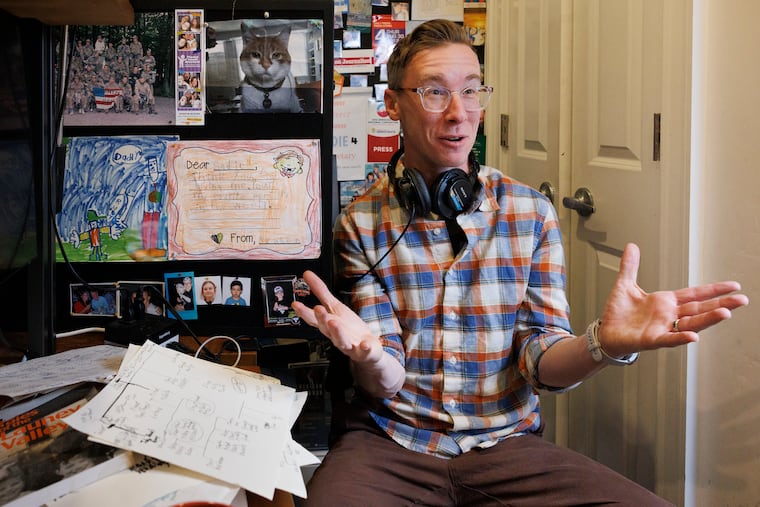A DNA test revealed Matt Katz was conceived by a sperm donor. His mother had no idea.
The history of donor insemination is filled with secrets and deception.

Matt Katz wanted to know where his Jewish ancestors once lived in Eastern Europe, so in 2016 he spit into a plastic vial and mailed in his DNA test. He expected to be 100% Ashkenazi Jewish.
Instead, he learned that half his DNA came from Ireland. He was shocked, but perhaps more jarring, so was his mother. She confirmed through her own test that she was indeed his biological mother and also 100% Ashkenazi Jewish.
The mystery transferred to his father.
Katz, now 45, already had a complicated relationship with fathers. The man he knew as his birth father largely disappeared from his life when he was 8 and his mother remarried a man named Richard Katz. As a child, Matt legally changed his last name to match. Richard legally adopted him; he was the one Matt called Dad, the one who played catch with him and taught him to ride a bike.
Now a DNA test suggested that Katz’s long-estranged father wasn’t even related to him. So who was his biological father? And how did his mother not know?
“My identity is all scrambled,” Katz said recently.
Katz’s surprise DNA results launched a five-year investigation into who his father was and the ethically vexed history of donor insemination, a twisting, satisfying story he tells in a new eight-part podcast called Inconceivable Truth. (His Google Doc for the project was titled “Daddy Issues.”) Katz, a longtime Inquirer reporter and now a radio journalist at WNYC, recorded most of it from his and his wife’s bedroom closet in Graduate Hospital, speaking into a microphone amidst the soundproofing presence of folded sweaters.
In this age of direct-to-consumer DNA tests, many, many people have discovered startling truths about how their families were made. Recent studies put the rates of so-called misattributed paternity — the situation Katz found himself in — between 1% and 4% of all births, according to an analysis by the New Yorker. Darker secrets have come out, too. Psychiatrists used to think that incest occurred among one in a million people. DNA testing now suggests the real number of people born to parents who are first-degree relatives (a brother and a sister; a parent and a child) may be closer to one in 7,000, according to unpublished research by British geneticist Jim Wilson recently reported in the Atlantic.
We live in what is perhaps a singular era for these genetic revelations: Older generations never imagined the kind of DNA technology that has developed, and younger generations will always operate with it in mind. The trend now is greater transparency and more access to information, spurred in part by donor-conceived activists.
But in this moment, there are still secrets to uncover and new family trees to create.
Katz’s quest was unusually complicated because his DNA revealed no grandparents, cousins, aunts, or uncles. With help from a volunteer on Facebook and another DNA test, Katz discovered that he had two half-sisters. One of them told Katz what she had only recently learned herself: She was conceived by a sperm donor.
In a recorded conversation with his mother after speaking with his half-sister, Katz asked whether his mother ever had fertility help. Yes, she said.
“Is it possible there was a sperm donor?” he asked.
“Not to my knowledge,” she said.
Seeking to process the new information, Katz set out to understand how babies such as him came to exist. Before assisted reproductive technology such as IVF took off, straight couples who struggled to conceive sometimes ended up using donor insemination. At the time, (mostly male) doctors believed it was in the best interest of everyone involved if the entire process was hidden, sometimes even from those intimately involved in it.
The first successful artificial insemination occurred in Philadelphia in 1884 and paved the way for generations of secrecy and deception, Katz found. A doctor realized that his female patient was married to a man with a low sperm count, so he inseminated the woman with a rubber syringe filled with the semen of a hand-selected medical student. The woman was never told.
Even decades later, secrecy remained the gold standard. Katz found a memo written by Alan Guttmacher, a well-known gynecologist and president of Planned Parenthood, from the 1940s laying out the ethical rules for donor insemination,
“Forget signed papers,” Guttmacher wrote. “They simply act as a permanent reminder of something which should be forgotten as quickly and completely as possible.”
By the 1970s, when Katz was conceived, ob/gyns sometimes chose sperm donors from among their medical residents or other available men, never creating or deliberately discarding any records. They strived to match a donor’s physical look with the father who would raise a child, so the child might never guess. They also routinely mixed donor sperm with a husband’s ineffective sperm, sometimes telling couples the donor’s sperm would “boost” the husband’s sperm.
Often, doctors would tell couples to go home and have sex after the insemination, encouraging the illusion that the husband was genetically related to a child actually conceived through donor insemination.
Once Katz understood that he had been donor-conceived, he set out to find the Irish doctor he believed would be his father. Inconceivable Truth, which is releasing one episode a week, follows that quest.
“Presence is really what makes a dad,” Katz said. “But I feel the pull of the biology.”